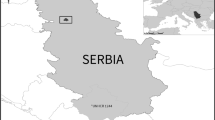Abstract
In this paper, requirements to the meteorological observational network density and accuracy of measurement of meteorological variables, which are necessary to enhance the effectiveness and lead time of the dangerous weather phenomena forecasts, are considered. An effective technically and economically feasible way of development of the specialized automatic meteorological network based on the existing and consistently developing cell phone network is proposed.
Similar content being viewed by others
References
A. I. Bedritskii, A. A. Korshunov, and M. Z. Shaimardanov, Dangerous Weather Phenomena and Their Impact on Russia Economy (VNIIGMI-MTsD, Obninsk, 2001) [in Russian].
L. S. Gandin and R. L. Kagan, Statistical Methods of Meteorological Data Interpretation (Gidrometeoizdat, Leningrad, 1976) [in Russian].
The Hydrometeorological Hazards, Special Issue, Ed. by G. S. Golitsyn and A. A. Vasil’ev, Ser. Natural Hazards of Russia, Ed. by V. I. Osipov and S. K. Shoigu (KRUK, Moscow, 2001) [in Russian].
Observations on the USSR’s Observational Network. Definition of Terms and Evaluation of Accuracy of Hydrometeorological Observations, Ed. by O. A. Gorodetskii (Gidrometeoizdat, Leningrad, 1970) [in Russian].
Taifun Scientific Industrial Association. A Flyer (NPO Taifun, Obninsk, 2007) [in Russian].
V. N. Ivanov, “Use of the IEM High-altitude Meteorological Mast for Studying the Atmosphere Boundary Layer,” Trudy IEM, No. 12 (1970) [Trans. Inst. Experimental Meteorol., No. 12 (1970)].
On the Current State and Measures to Support and Develop the Climate Observations System, Data Acquisition and Processing, Databases Formation, and Their Availability for Consumers, Materials of the Roshydromet Panel Meeting on February 27, 2007, Attachment 2: A Description of the Roshydromet Climate Observation Networks (Surface Observations) (Roshydromet, Moscow, 2007) [in Russian].
Modernization and Technical Re-equipping of the Roshydromet Institutions and Organizations. The Observational Network: Project Solutions and Prospectives of Development, Proc. of the Meeting (Seminar) (VNIIGMI-MTsD, Obninsk, 2006) [in Russian].
V. P. Meleshko and I. P. Guseva, “Computation of Some Static Characteristics of the Temperature and Humidity Fields,” Trudy GGO, No. 165 (1964) [Trans. Main Geophysical Observatory, No. 165 (1964)].
A. G. Melikhova, “Selection of Intervals of the Wind Speed Averaging and Methodology of Computation of Wind Squalls,” Trudy GGO, No. 129 (1962) [Trans. Main Geophysical Observatory, No. 129 (1962)].
Instruction for Hydrometeorological Stations and Gauges, Vol. 3, Pt. 1: Meteorological Observations at the Stations (Gidrometeoizdat, Leningrad, 1985) [in Russian].
On the Content, Accuracy and Spatiotemporal Resolution of Data Necessary for Hydrometeorological Support of the National Economy and Hydrometeorological Forecast Service, Ed. by M. A. Petrosyants and V. D. Reshetov (Gidrometeoizdat, Leningrad, 1975) [in Russian].
M. B. Fridzon and Yu. M. Ermoshenko, Patent of Invention (a useful model) “A Network of Meteorological Stations,” No. 66431, April 20, 2007, Patent Holder: Gidrometpostavka Federal State Unitary Enterprise.
B. E. Peskov, “A Study of the Thunderstorms and Squalls Development Conditions with Diagnostic Diagrams and Indices of Instability,” Trudy Gidromettsentra SSSR, No. 13 (1967) [Trans. Hydrometeorological Res. Center of the USSR, No. 13 (1967)].
B. E. Peskov and A. I. Snitkovskii, “Toward the Strong Squalls Forecasting,” Meteorol. Gidrol., No. 7 (1986) [Sov. Meteorol. Hydrol., No. 7 (1986)].
V. D. Reshetov, Variability of Meteorological Elements in the Atmosphere (Gidrometeoizdat, Leningrad, 1973) [in Russian].
Instruction for the Short-term Weather Forecasts, Pt. 2: The Weather Forecasting (Gidrometeoizdat, Leningrad, 1985) [in Russian].
A Register of Hydrometeorological Organization of the Roshydromet Observational Network as of January 1, 2003 (Gidrometeoizdat, St. Petersburg, 2003) [in Russian].
Author information
Authors and Affiliations
Additional information
Original Russian Text © M.B. Fridzon, Yu.M. Ermoshenko, 2009, published in Meteorologiya i Gidrologiya, 2009, No. 2, pp. 93–100.
About this article
Cite this article
Fridzon, M.B., Ermoshenko, Y.M. Development of the specialized automatic meteorological observational network based on the cell phone towers and aimed to enhance feasibility and reliability of the dangerous weather phenomena forecasts. Russ. Meteorol. Hydrol. 34, 128–132 (2009). https://doi.org/10.3103/S1068373909020101
Received:
Published:
Issue Date:
DOI: https://doi.org/10.3103/S1068373909020101




